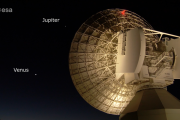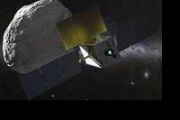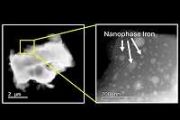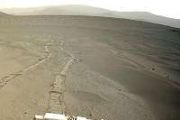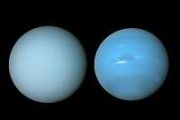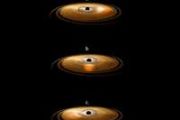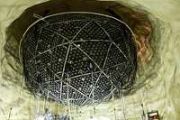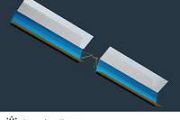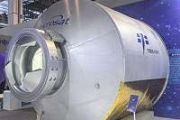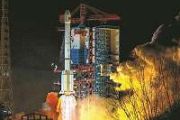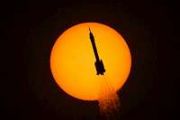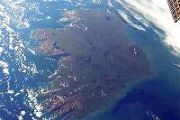
Copernical Team
New particle model opens overlooked pathway in dark matter search
 A team of physicists from the University of Sao Paulo (USP) in Brazil has introduced a new theoretical framework that could advance the search for dark matter by focusing on inelastic particles that interact with ordinary matter through a novel type of force carrier. Their study, published in the Journal of High Energy Physics, proposes a model involving a massive vector boson that enables inter
A team of physicists from the University of Sao Paulo (USP) in Brazil has introduced a new theoretical framework that could advance the search for dark matter by focusing on inelastic particles that interact with ordinary matter through a novel type of force carrier. Their study, published in the Journal of High Energy Physics, proposes a model involving a massive vector boson that enables inter Galactic Center magnetic field offers new insight into stellar evolution dynamics
 A new study of the Sagittarius C region in the Milky Way's Central Molecular Zone has revealed a detailed portrait of the galactic magnetic field, offering fresh insight into how dense gas clouds, star formation, and high-energy particles interact at the heart of our galaxy.
Sagittarius C, a complex star-forming zone within a dense cloud ring near the Galactic Center, has long intrigued as
A new study of the Sagittarius C region in the Milky Way's Central Molecular Zone has revealed a detailed portrait of the galactic magnetic field, offering fresh insight into how dense gas clouds, star formation, and high-energy particles interact at the heart of our galaxy.
Sagittarius C, a complex star-forming zone within a dense cloud ring near the Galactic Center, has long intrigued as Expanded KSAT AWS Alliance Redefines Satellite Ground Communication Services
 Kongsberg Satellite Services (KSAT) has announced an expanded collaboration with Amazon Web Services (AWS), aimed at redefining satellite ground station services through a unified integration of KSAT's global infrastructure and AWS's cloud technologies.
The partnership will incorporate AWS Ground Station capabilities into KSAT's existing commercial offerings, delivering improved scalabilit
Kongsberg Satellite Services (KSAT) has announced an expanded collaboration with Amazon Web Services (AWS), aimed at redefining satellite ground station services through a unified integration of KSAT's global infrastructure and AWS's cloud technologies.
The partnership will incorporate AWS Ground Station capabilities into KSAT's existing commercial offerings, delivering improved scalabilit China advances satellite internet network with sixth orbital deployment
 China successfully launched the sixth batch of low Earth orbit internet satellites on Wednesday using a Long March 8A rocket, further expanding its national satellite internet network. The launch took place at 3:49 pm local time from the Hainan International Commercial Aerospace Launch Center in Wenchang, as reported by China Aerospace Science and Technology Corp (CASC).
The latest satelli
China successfully launched the sixth batch of low Earth orbit internet satellites on Wednesday using a Long March 8A rocket, further expanding its national satellite internet network. The launch took place at 3:49 pm local time from the Hainan International Commercial Aerospace Launch Center in Wenchang, as reported by China Aerospace Science and Technology Corp (CASC).
The latest satelli NASA teams with India to launch Earth-tracking satellite
 NASA announced Wednesday it, in a partnership with the Indian Space Research Organization, launched a radar system to map Earth as never before.
The NASA-ISRO Synthetic Aperture Radar, or NISAR, satellite blasted off from Satish Dhawan Space Centre on the island of Sriharikota in the state of Andhra Pradesh in India at 8:10 a.m. EDT Wednesday.
NISAR, which NASA described in a pre
NASA announced Wednesday it, in a partnership with the Indian Space Research Organization, launched a radar system to map Earth as never before.
The NASA-ISRO Synthetic Aperture Radar, or NISAR, satellite blasted off from Satish Dhawan Space Centre on the island of Sriharikota in the state of Andhra Pradesh in India at 8:10 a.m. EDT Wednesday.
NISAR, which NASA described in a pre China launches remote sensing satellite for Pakistan using Kuaizhou rocket
 China successfully launched a remote sensing satellite for Pakistan on Thursday morning aboard a Kuaizhou 1A carrier rocket from the Xichang Satellite Launch Center in Sichuan province. The launch occurred at 10 am local time, with the solid-fueled rocket placing the satellite into its designated orbit.
The satellite, designed and manufactured by the Innovation Academy for Microsatellites
China successfully launched a remote sensing satellite for Pakistan on Thursday morning aboard a Kuaizhou 1A carrier rocket from the Xichang Satellite Launch Center in Sichuan province. The launch occurred at 10 am local time, with the solid-fueled rocket placing the satellite into its designated orbit.
The satellite, designed and manufactured by the Innovation Academy for Microsatellites Chinese sub discovers deepest-ever creatures 10 km undersea
 A Chinese submersible has discovered thousands of worms and molluscs nearly 10 kilometres (six miles) below sea level in the Mariana Trench, the deepest colony of creatures ever observed, a study revealed on Wednesday.
The discovery in Earth's deepest underwater valley suggests that there could be much more life thriving in the hostile conditions at the bottom of our planet's largely unexplo
A Chinese submersible has discovered thousands of worms and molluscs nearly 10 kilometres (six miles) below sea level in the Mariana Trench, the deepest colony of creatures ever observed, a study revealed on Wednesday.
The discovery in Earth's deepest underwater valley suggests that there could be much more life thriving in the hostile conditions at the bottom of our planet's largely unexplo Cosmic shield breakthrough could extend life of space solar cells
 A new radiation-resistant coating developed at the University of Surrey could significantly improve the durability of next-generation perovskite solar cells in space. The innovation promises to make satellite solar panels lighter, more efficient, and less costly than traditional alternatives.
Engineers from Surrey's Advanced Technology Institute, in collaboration with Oxford University, th
A new radiation-resistant coating developed at the University of Surrey could significantly improve the durability of next-generation perovskite solar cells in space. The innovation promises to make satellite solar panels lighter, more efficient, and less costly than traditional alternatives.
Engineers from Surrey's Advanced Technology Institute, in collaboration with Oxford University, th SpaceX Dragon delivers Crew-11 to International Space Station
 The four Crew-11 crew members joined seven other astronauts in the International Space Station early Saturday morning following a 15-hour journey from Kennedy Space Center in Florida.
NASA astronauts Zena Cardman and Mike Fincke, Japan Aerospace Exploration Agency astronaut Kimiya Yui, and Roscosmos cosmonaut Oleg Platonov, entered the ISS at 3:46 a.m. EDT, NASA said.
At 2:27 a.m
The four Crew-11 crew members joined seven other astronauts in the International Space Station early Saturday morning following a 15-hour journey from Kennedy Space Center in Florida.
NASA astronauts Zena Cardman and Mike Fincke, Japan Aerospace Exploration Agency astronaut Kimiya Yui, and Roscosmos cosmonaut Oleg Platonov, entered the ISS at 3:46 a.m. EDT, NASA said.
At 2:27 a.m Is SpaceX's Stock Price Affected by Trump's Supportive Politics over Bitcoin?
 If there are people and trends that are currently shaping the world, it would have to be the new President of the USA, Donald Trump, and his trusted advisor, billionaire inventor and entrepreneur, Elon Musk. Musk's SpaceX company is another big name everyone knows, and so is Bitcoin, the leading cryptocurrency. But how are they connected, and why do they depend on each other for success and a sa
If there are people and trends that are currently shaping the world, it would have to be the new President of the USA, Donald Trump, and his trusted advisor, billionaire inventor and entrepreneur, Elon Musk. Musk's SpaceX company is another big name everyone knows, and so is Bitcoin, the leading cryptocurrency. But how are they connected, and why do they depend on each other for success and a sa 












